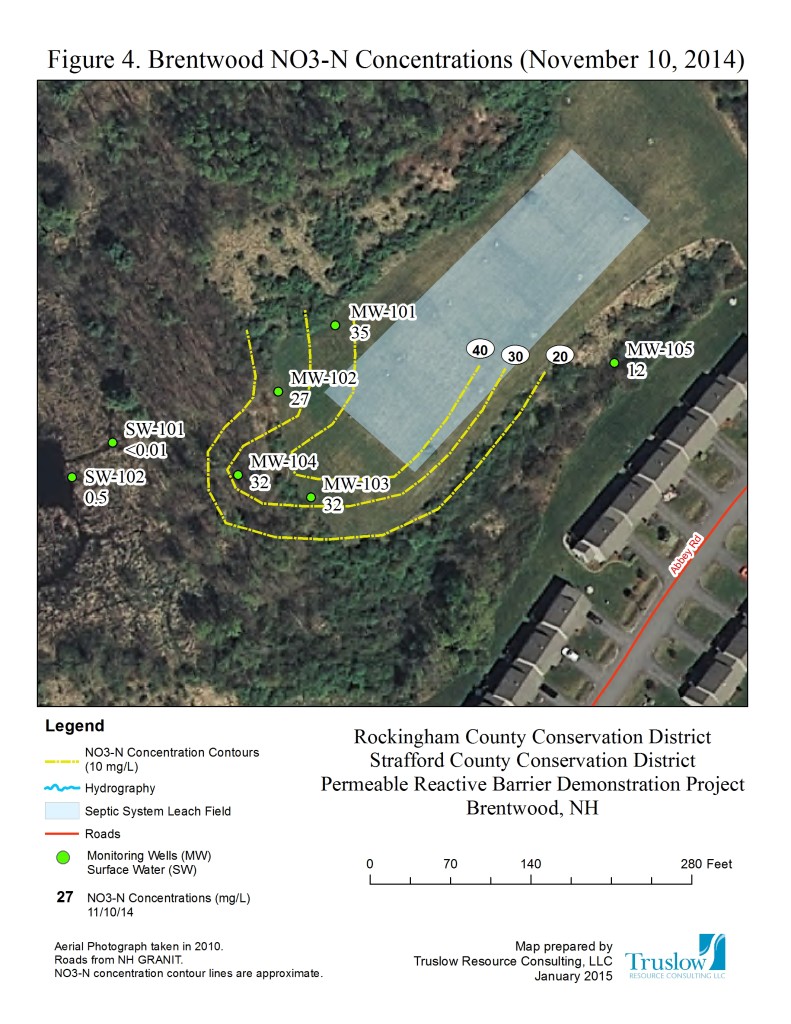PROBLEM | Great Bay in Seacoast New Hampshire has been identified as an impaired water body for excess total nitrogen levels. Many non-point sources have been identified, including nitrogen from septic effluent. Mechanical on-site septic system technologies to remove nitrogen from effluent are expensive and subject to mechanical failure. Alternative technologies to reduce nitrate in groundwater before discharging to surface water are being studied, including Permeable Reactive Barriers.
SOLUTION & METHOD | This passive technology called a Permeable Reactive Barrier (PRB) can control nitrogen with a formulation of wood chips, additives, and sand or gravel to transform inorganic nitrogen to nitrogen gas. This technology can be used in conjunction with an existing or new septic system to reduce nitrogen migration to sensitive watershed areas. The Rockingham County Conservation District received a grant from the New Hampshire Department of Environmental Services (NHDES) to develop two pilot testing sites to evaluate the effectiveness of this type of PRB. Truslow Resource Consulting LLC was hired as the project manager and environmental sampling task manager for the study to test the feasibility of the technology for widespread use. The goal of the project was to design and install PRBs in two settings to provide an assessment of the PRB technology for reducing nitrogen inputs from septic systems to shallow groundwater and surface waters in the Great Bay Watershed.
 Two pilot sites were selected – in Durham and Brentwood, NH. The Durham location is adjacent to an existing homeowner septic system close to Chesley Brook in the Oyster River Watershed. The Brentwood location is adjacent to a community septic system leach field. This system is located adjacent to a wetland and perennial stream, which drains to Dudley Brook in the middle of the Exeter River Watershed.
Two pilot sites were selected – in Durham and Brentwood, NH. The Durham location is adjacent to an existing homeowner septic system close to Chesley Brook in the Oyster River Watershed. The Brentwood location is adjacent to a community septic system leach field. This system is located adjacent to a wetland and perennial stream, which drains to Dudley Brook in the middle of the Exeter River Watershed.
PRB installation was completed in October 2015 at the Brentwood site and in May 2016 at the Durham site . Pre- and post-installation groundwater and surface water monitoring helped demonstrate the success of the project as well as implementation challenges and solutions that can be incorporated into later siting evaluation and implementation programs. Multiple presentations were made throughout the project concluding with a half-day nitrate workshop presented to over 70 attendees including geologists, engineers, septic installers and municipal environmental staff.
A final report that reviews the project and results of system monitoring was submitted to NHDES in late 2017. Preliminary estimates suggest an 82% reduction in nitrate at the community septic field and a 95% reduction at the individual septic leach field.
Client/Collaborators
- Rockingham County Conservation District
- Strafford County Conservation District
- NHDES
Services Provided
- Hydrology, Geomorphology, & Restoration
- Groundwater and Surface Water Quality Sampling
- Resource Planning and Management
- GIS Mapping and Analysis